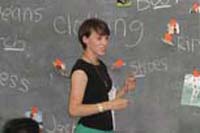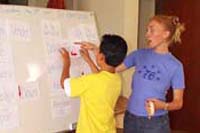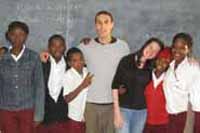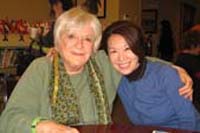Welcome to Basic Training and Resources for Teaching English to Speakers of Other Languages (BTR-TESOL)!
BTR-TESOL ("Better TESOL") is designed to provide basic training ("the least you should know") and resource connections ("where to go to learn more") for people who....
- Are either (a) on the verge of teaching ESL/EFL or (b) already practicing TESOL in one way or another (as tutors, conversation partners, teachers, etc.) and…
- Have no academic background or professional preparation in TESOL, but want such guidance, even though they are not currently in a position (due to finances, timing, location) to get a full-scale TESOL degree or certificate.
Does that sound like you? Well, if so, then this program may be just what you need!
How the site is designed
The site contains nearly 50 units, organized in the 10 sections listed under the menu. A complete listing of the units appears below. The units cover a broad range of teacher-preparation topics, divided into 10 major areas:
1. Introduction: Basic Concepts
A. “The Least You Should Know” (the purposes and delimitations of this program and suggestions for follow-up TESOL courses, resources, and professional organizations).
B. Differences between teaching English as a second language (ESL) and English as a foreign language (EFL).
C. Tutoring vs. teaching: How they are different.
D. Dealing with cultural differences and culture shock (in your students and yourself).
E. Working successfully within foreign educational and administrative systems.
2. Designing Language-teaching Programs, Courses, and Lessons
A. Setting up and operating successful courses for adult English language learners (i.e., administrative concerns).
B. Planning a curriculum that fits your students and meets their needs.
C. Designing effective lessons for language learning and teaching (i.e., curriculum and lesson planning).
D. Assessing your students' language proficiency (for course design purposes and for determining student placement).
3. Developing Fundamental Teaching Skills
A. Developing a successful teaching personality.
B. Adjusting your spoken English to make it comprehensible and helpful to English language learners at various levels of proficiency.
C. Managing classes of English language learners (encouraging participation, maintaining discipline, building a supportive sense of community, avoiding demeaning or negative behavior, setting up groups, dealing with multiple levels of proficiency in the same class).
D. Correcting language learners’ errors productively, and developing their self-monitoring skills.
4. Understanding Key Principles Behind Successful Language Teaching
A. Understanding basic principles of second language acquisition.
B. Creating and using exercises for mechanical, meaningful, and communicative practice.
C. Using communicative language teaching principles and information gap exercises.
D. Encouraging cooperative and collaborative learning to increase student interaction.
E. Creating activities that provide imitative, rehearsed, and extemporaneous practice.
F. Developing an awareness of teaching styles and cross-cultural style differences.
5. Knowing Your Students: Learner Types, Styles, and Strategies
A. Understanding, respecting, and appreciating adult ESL learners.
B. Working successfully with young English language learners.
C. Understanding your students’ language learning styles—including cross-cultural differences in learning styles—and then teaching them accordingly.
D. Recognizing multiple intelligences and their implications for language teaching.
E. Teaching your students to use language-learning strategies commonly employed by successful language learners.
6. Developing Language Skills
A. Developing English language learners' listening skills.
B. Developing English language learners' speaking skills.
C. Developing English language learners' reading skills.
D. Developing English language learners' writing skills.
E. Integrating multiple language skills in one class.
F. Teaching content-based language classes.
7. Teaching English Language Components
A. The least you should know about English grammar and how to teach it.
B. The least you should know about English pronunciation and how to teach it.
C. Planned and unplanned vocabulary teaching.
D. Vocabulary teaching and learning strategies that work well.
E. Understanding and teaching about culture.
8. Making Language Teaching and Learning Enjoyable and Memorable
A. Conducting effective and enjoyable conversation classes.
B. Using songs and chants to increase participation, recall, and enjoyment.
C. Using games, and other fun yet effective activities for English language teaching.
D. Using computers and Internet resources for English language teaching.
E. Using video for teaching English.
9. Testing English Language Skills
A. Widely used general proficiency tests (e.g., TOEFL, BEST, CET).
B. Developing valid and reliable local measures of student achievement.
10. Choosing, Creating, and Adapting Language Teaching Materials
A. Locating, evaluating, and selecting authentic, effective print/electronic teaching materials for language learners.
B. Collecting and creating your own language-teaching materials.
C. Successfully adapting existing materials for greater teaching enjoyment and success.
Each unit contains the following elements:
- Introductory scenario
- Objectives of the unit
- Explanation of "the least you should know" about this topic
- Comprehension and reflection questions
- Video example related to this topic
- Reflection and responses
- "Where to go to learn more"
about this topic
- Connections to other units in this program
- Online and electronic resources
- Print and paper-based resources
|











